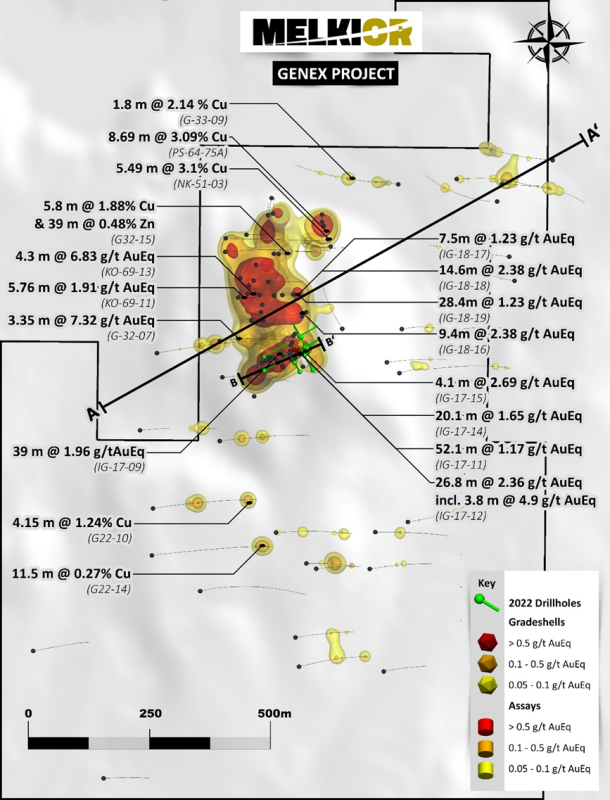Highlights:
Visual observations on approximately 1,207 metres of drilling completed across 9 holes located within 100 metres of the historical Genex underground infrastructure.
Disseminated to semi-massive polymetallic mineralization has been intersected in all holes drilled to date ranging in width from 2.2 to40.2 metres
A new volcanogenic massive sulfide lens with associated stringer intervals was discovered outside the historical Genex deposit.
Drilling was completed in late November, with the program totalling 4,223 metres
Timmins, Ontario – TheNewswire – December 15, 2022 – Melkior Resources Inc. (“Melkior” or the “Company”) (TSXV:MKR) (OTC:MKRIF) is pleased to provide a second visual update from its drill program completed at Genex, which commenced in early October. On April 21st, 2022, the Company announced an option agreement for the Genex Project to earn 100% over 7 years from International Explorers & Prospectors Inc (see news release dated April 21, 2022). The Genex Project is a gold-copper polymetallic VMS exploration target with significant near-term resource potential.
Figure 1: GEN-22-12 (106m)
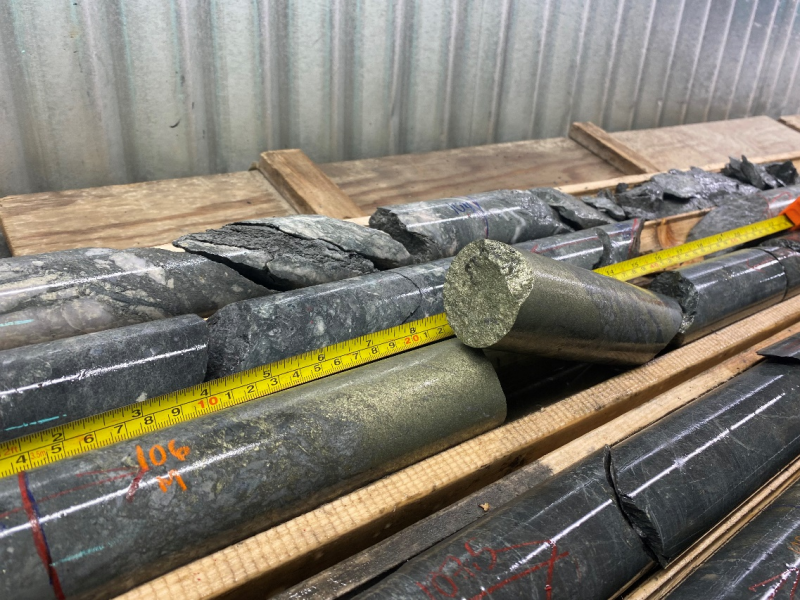
*The photos are of selected intervals and are not necessarily indicative of the mineralization hosted within the entirety of the drill holes
Drilling
This update includes 9 holes totalling 1,207 metres ranging in depth between 75 and 220 metres, targeting infill and extension targets around the historical Genex Mine (see following diagram). From logging, 5 holes out of 9 returned at least one mineralized interval over 10 metres hosting disseminated chalcopyrite-pyrite, pyrite-sphalerite and/or pyrite. Three holes drilled in two different areas host massive or semi-massive intervals embedded in the disseminated sulfide envelope.
Genex Infill:
Holes GEN-22-10, and GEN-22-13 were drilled about 30 metres east of the shaft area to test the near surface up-dip extension of the Genex structure. Hole GEN-22-14 was drilled across the underground workings using a north north-west azimuth to test the potential for large near-surface disseminated mineralization. In this hole, repeated sulfide clusters, veins and stringer zones hosting up to 10% chalcopyrite with accessory sphalerite over metric intervals were observed from a depth of 25 to 110 metres along hole. The host rock is a volcanic breccia of intermediate composition affected by zones of strong chloritization, carbonatization and sericitization.
South West Extension:
GEN-22-08, GEN-22-09, GEN-22-17 and GEN-22-18, tested the geometry of a western extension of the Genex system up to a distance of about 100 metres from the known deposit. The first two holes tested the down dip potential while GEN-22-17 and GEN-22-18 were planned to test a possible updip extension close to surface and lateral continuity.
The most significant observations were made on hole GEN-22-18, where two sulfide occurrences were identified. A chalcopyrite stringer zone is present from 70.3 to 89.7m, hosted in massive mafic to intermediate vesicular volcanic flows affected by moderate carbonate-chlorite alteration. The second mineralized interval is defined from 101.8 to 111.0m. The mineralization is an example of volcanogenic massive pyrite-chalcopyrite layers with associated stringers located at the contact between the Genex felsic fragmentary unit and massive andesite. The high level of chloritization and carbonatization tends to obscure primary contacts.
Figure 2: GEN-22-18 (105.6m)
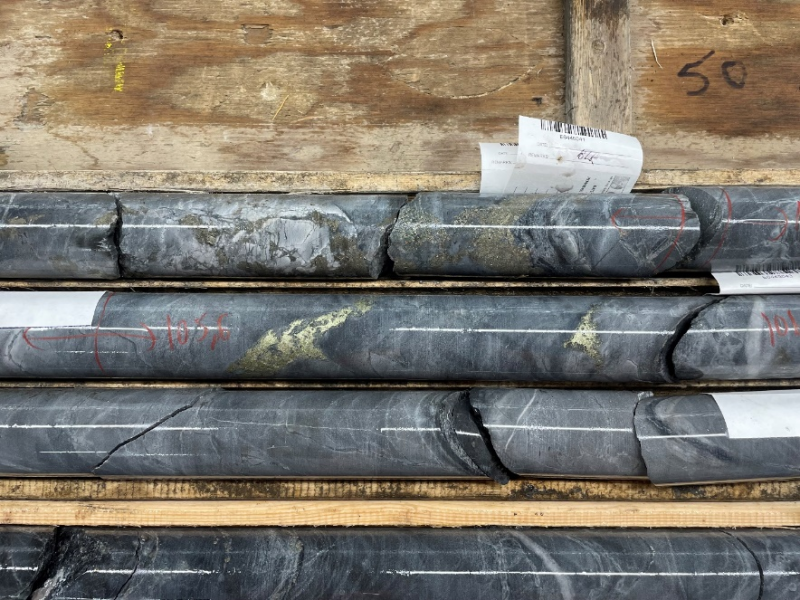
Genex Down Plunge:
GEN-22-11 and GEN-22-12 were drilled to cover a potential southward continuity of the Genex system. The most encouraging observations were obtained from hole GEN-22-12, where a true VMS (volcanogenic massive sulfide lens) occurs at about 50 metres from the historical Genex mineralization and is hosted in a distinct volcanic sequence. The new mineralization takes the form of massive chalcopyrite-pyrite lenses hosted by volcanic tuffs from 106 to 117.5 metres along hole. A volcanic contact at 33 metres marks a clear change from sericite to chlorite contact alteration.
Figure 3: GEN-22-12 (108m)
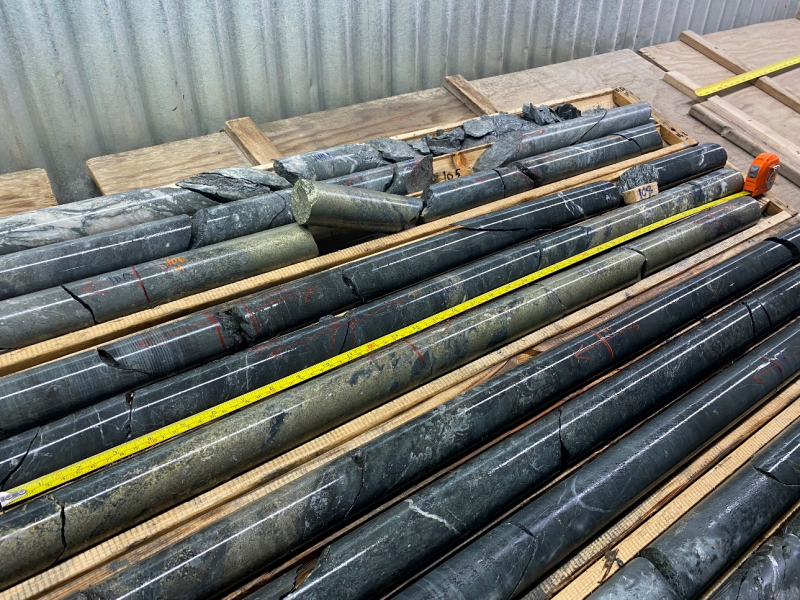
Visual Intercept Highlights:
The following observations were made as indications of the Genex Au-Cu Zone, but they have not yet been correlated with gold, copper, zinc or silver grades.
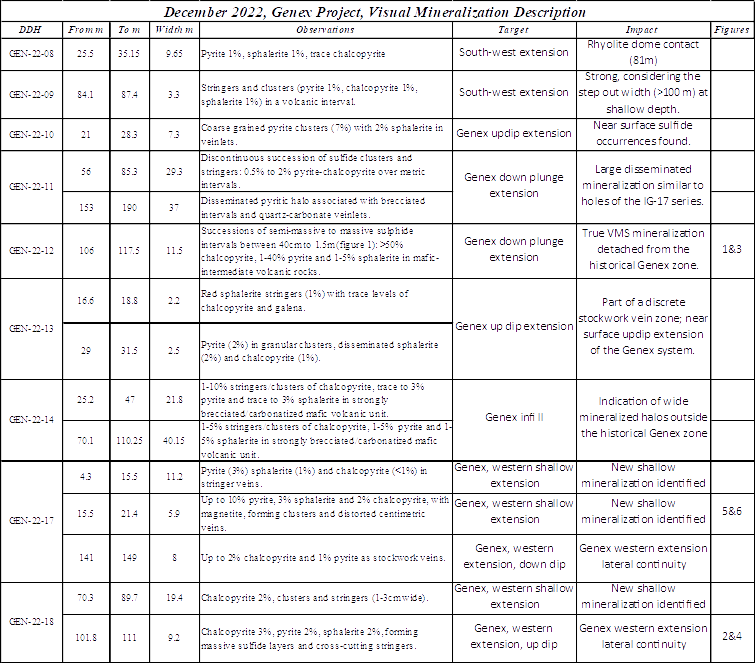
*For a full list of figures please refer to this link.
** GEN-22-15 & 16 were not drilled.
Drill Hole Coordinates
DDH | Az | Dip | Length | UTM NAD83 z17 – E | UTM NAD83 z17 – N | Elevation (ASL) |
GEN-22-08 | 150 | -85 | 105 | 458773 | 5370091 | 344 |
GEN-22-09 | 60 | -75 | 200 | 458648 | 5370058 | 346 |
GEN-22-10 | 60 | -65 | 147 | 458815 | 5370155 | 349 |
GEN-22-11 | 330 | -60 | 220 | 458848 | 5370061 | 351 |
GEN-22-12 | 150 | -66 | 120 | 458813 | 5370122 | 350 |
GEN-22-13 | 60 | -66 | 75 | 458813 | 5370122 | 350 |
GEN-22-14 | 330 | -50 | 105 | 458800 | 5370196 | 348 |
GEN-22-17 | 330 | -60 | 149 | 458671 | 5370117 | 346 |
GEN-22-18 | 330 | -57 | 95 | 458728 | 5370120 | 346 |
3D Plan View of the Genex Gold-Copper System*
*Gold-equivalent grade shells (gold + copper + zinc + silver) based on inverse distance interpolation using Leapfrog software.
Qualified Person
All technical information in this press release has been reviewed and approved by Peter Caldbick, P.Geo. Mr. Caldbick is a consultant for Melkior and a Qualified Person for the purposes of National Instrument 43-101.
About Melkior Resources
Melkior Resources is an exploration stage resource company in world-class mining jurisdictions with a strong partner. Melkior’s flagship Carscallen Project is being advanced by Kirkland Lake Gold (now Agnico Eagle Mines) through a $110M option/joint venture agreement. Melkior under 100% ownership is focused on advancing its Genex, Val D’Or, White Lake and Maseres Projects. Agnico Eagle Mines currently owns approximately 6% of the Company.
ON BEHALF OF THE BOARD
Jonathon Deluce, CEO




